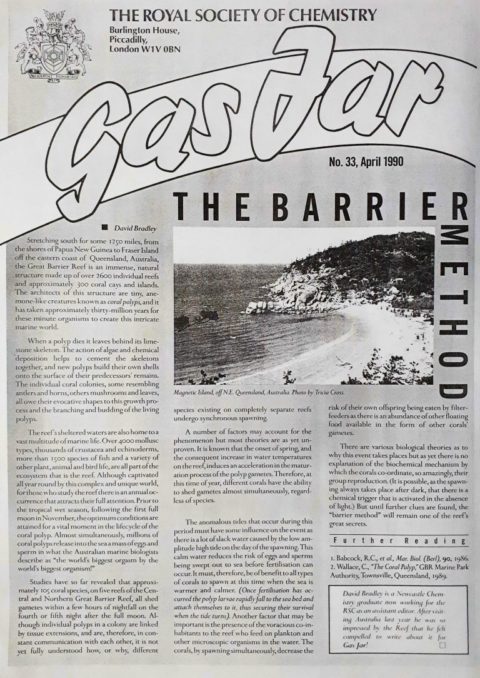Thirty years ago this month I wrote my first professional article. It was a short feature about the biggest organism having the biggest orgasm and was entitled ‘The Barrier Method’. It explained some of the chemistry, biology, and geography of the sex life of Australia’s Great Barrier Reef and appeared in the April 1990 issue of the Royal Society of Chemistry’s young chemists’ newsletter Gas Jar.

Incidentally, I later renamed the magazine and helped relaunch it in full colour as New Elements with Editor Dr Mandy Mackenzie, which carried my Elemental Discoveries news round-up for several years from 1995 onwards.
I also used to publish Elemental Discoveries online on what was perhaps the first chemistry news website. It was to become a model for several news site launches over the following years that I instigated or was involved with for various organisations, including Reactive Reports for ACD/Labs, PSIGate Spotlight, which became Intute, Spectral Lines (for Wiley, now SpectroscopyNOW.com), Distillates for the RSC magazine Education in Chemistry, and a couple of others. Elemental Discoveries itself was hosted by ChemDraw creators Cambridge Soft for a couple of years before I relaunched it as Sciencebase.com in July 1999.
The article ‘The Barrier Method’ was chosen as runner-up in the 1990 Young Science Writer Awards hosted by The Daily Telegraph and the British Association for the Advancement of Science. A later article entitled “Not every sperm is sacred” won in 1991 and led to my writing about science for The Telegraph for several years after that. I got a merit award after the sperm and eggs with an article about xenon and anaesthesia, but sex science has remained a focus of much of my writing over the years, hah!
You can see a hopefully complete list of all my clients from the last thirty years as a freelance science writer here.
The photo accompanying the article was by Mrs Sciencebase long before she was Mrs Sciencebase. I can’t find the original magazine, hence the monochrome copy.